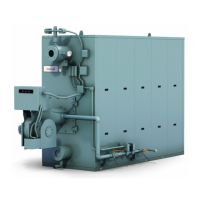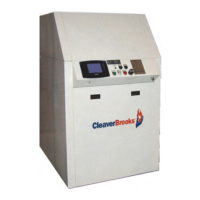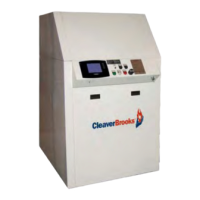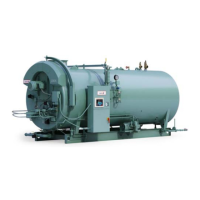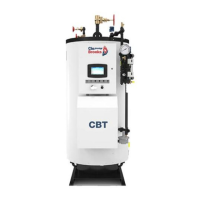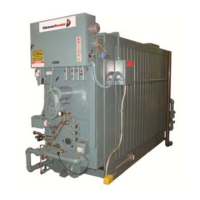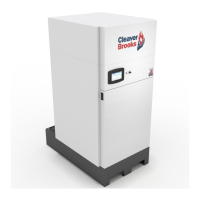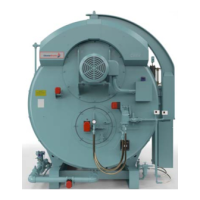Adjustment Procedures Chapter 6
750-177 6-5
utilization of the modulating firing system. To accomplish
maximum utilization, and assuming that air/fuel combustion
ratios have been set, make the required adjustments to the
controls to bring the boiler pressure or temperature up to meet
the load requirements.
To properly set the modulating control, carefully adjust it
under load conditions, until the load is maintained with the
burner firing at a steady rate. The firing rate at that point may
be full high fire or slightly less, depending upon the
relationship of the boiler size to the load.
When the modulating control is set and the burner is in full
high fire, the scale setting of the
modulating pressure control
on a steam boiler will indicate the low point of the modulating
range. The scale setting of the
modulating temperature
control on a hot water boiler will have a reading that indicates
the midpoint of the modulating range.
The operating limit control should now be adjusted and the
differential established. In an installation that does not require
a very close control of steam pressure or water temperature
the adjustable differential (Figure 6-4 A to B) should be set as
wide as conditions permit, since a wide setting will provide
less frequent burner cycling.
The high limit control provides a safety factor to shut the
burner off in the event the
operating limit control should fail.
The setting of the control should be sufficiently above the
operating limit control to avoid nuisance shutdowns. The
setting, however, must be within the limits of the safety valve
settings and should not exceed 90% of the valve setting. The
control requires manual resetting after it shuts off the burner.
In the setting of the controls, consideration must be given to
the time required for a burner restart. Each start, requires a
prepurge period, plus the fixed time required for proving the
pilot and main flame. In addition, approximately one-half
minute is required for the damper motor to travel from low to
high fire. The time lag may allow pressure or temperature to
drop below desirable limits.
F. MODULATING PRESSURE
CONTROL (Steam)
Turn the adjusting screw until the indicator is opposite the
low point of the desired modulating range. Modulated firing
will range between the low point and a higher point equal to
the modulating range of the particular control. In 0-15 psi
controls the range is 1/2 psi.
!
DANGER
CAUTION
To prevent burner shutdown at other than
low-fire setting, adjust the modulating pres
-
sure control to modulate to low fire BEFORE
the operating limit pressure control shuts
off the burner. Failure to follow these in
-
structions could result in damage to the
equipment
G. OPERATING LIMIT PRESSURE
CONTROL (Steam)
Set the “cut-out” (burner-off) pressure on the main scale
using the large adjusting screw. Set the differential on the
short scale by turning the small adjusting screw until the
indicator points to the desired difference between cut-out and
cut-in pressures. The “cut-in” (burner-on) pressure is the cut-
out pressure MINUS the differential. The cut-out pressure
should not exceed 90% of the safety valve setting.
H. HIGH LIMIT PRESSURE
CONTROL (Steam)
Set “cut-out” (burner off) pressure on the main scale using
the adjusting screw. The control will break a circuit when
pressure reaches this point. The setting should be sufficiently
above the operating limit pressure control to avoid
shutdowns, and preferably not exceed 90% of safety valve
setting. The control requires manual resetting after tripping
on a pressure increase. To reset, allow pressure to return to
normal and then press the reset button.
Figure 6-5: Steam Operating Controls
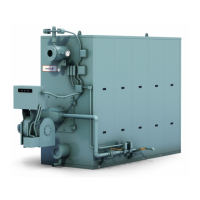
